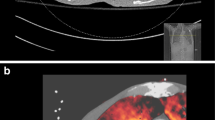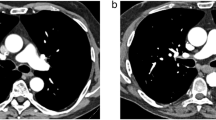Abstract
Objectives
To evaluate the use of dual-energy CT imaging of the lung perfused blood volume (PBV) for the detection of pulmonary fat embolism (PFE).
Methods
Dual-energy CT was performed in 24 rabbits before and 1 hour, 1 day, 4 days and 7 days after artificial induction of PFE via the right ear vein. CT pulmonary angiography (CTPA) and lung PBV images were evaluated by two radiologists, who recorded the presence, number, and location of PFE on a per-lobe basis. Sensitivity, specificity, and accuracy of CTPA and lung PBV for detecting PFE were calculated using histopathological evaluation as the reference standard.
Results
A total of 144 lung lobes in 24 rabbits were evaluated and 70 fat emboli were detected on histopathological analysis. The overall sensitivity, specificity and accuracy were 25.4 %, 98.6 %, and 62.5 % for CTPA, and 82.6 %, 76.0 %, and 79.2 % for lung PBV. Higher sensitivity (p < 0.001) and accuracy (p < 0.01), but lower specificity (p < 0.001), were found for lung PBV compared with CTPA. Dual-energy CT can detect PFE earlier than CTPA (all p < 0.01).
Conclusion
Dual-energy CT provided higher sensitivity and accuracy in the detection of PFE as well as earlier detection compared with conventional CTPA in this animal model study.
Key points
• Fat embolism occurs commonly in patients with traumatic bone injury.
• Dual-energy CT improves diagnostic performance for pulmonary fat embolism detection.
• Dual-energy CT can detect pulmonary fat embolism earlier than CTPA.




Similar content being viewed by others
Abbreviations
- CTPA:
-
Computed tomography pulmonary angiography
- FES:
-
Fat embolism syndrome
- MIP:
-
Maximum intensity projection
- PE:
-
Pulmonary embolism
- PFE:
-
Pulmonary fat embolism
- PBV:
-
Perfusion blood volume
- PPV:
-
Positive predictive value
- NPV:
-
Negative predictive value
References
Mellor A, Soni N (2001) Fat embolism. Anaesthesia 56:145–154
Talbot M, Schemitsch EH (2006) Fat embolism syndrome: history, definition, epidemiology. Injury 37:S3–S7
Taviloglu K, Yanar H (2007) Fat embolism syndrome. Surg Today 37:5–8
Hofman S, Huemer G, Salzer M (1998) Pathophysiology and management of the fat embolism syndrome. Anaesthesia 53(Suppl 2):35–37
Mudd KL, Hunt A, Matherly RC et al (2000) Analysis of pulmonary fat embolism in blunt force fatalities. J Trauma 48:711–715
Gallardo X, Castañer E, Mata JM, Rimola J, Branera J (2006) Nodular pattern at lung computed tomography in fat embolism syndrome: a helpful finding. J Comput Assist Tomogr 30:254–257
Tang CX, Zhang LJ, Han ZH et al (2013) Dual-energy CT based vascular iodine analysis improves sensitivity for peripheral pulmonary artery thrombus detection: an experimental study in canines. Eur J Radiol 82:2270–2278
Johnson TR, Krauss B, Sedlmair M et al (2007) Material differentiation by dual energy CT: initial experience. Eur Radiol 17:1510–1517
Sakamoto A, Sakamoto I, Nagayama H, Koike H, Sueyoshi E, Uetani M (2014) Quantification of lung perfusion blood volume with dual-energy CT: assessment of the severity of acute pulmonary thromboembolism. AJR Am J Roentgenol 203:287–291
Nagayama H, Sueyoshi E, Hayashida T, Ashizawa K, Sakamoto I, Uetani M (2013) Quantification of lung perfusion blood volume (lung PBV) by dual-energy CT in pulmonary embolism before and after treatment: preliminary results. Clin Imaging 37:493–497
Meinel FG, Graef A, Thieme SF et al (2013) Assessing pulmonary perfusion in emphysema: automated quantification of perfused blood volume in dual-energy CTPA. Invest Radiol 48:79–85
Chai X, Zhang LJ, Yeh BM, Zhao YE, Hu XB, Lu GM (2012) Acute and subacute dual energy CT findings of pulmonary embolism in rabbits: correlation with histopathology. Br J Radiol 85:613–622
Bauer RW, Frellesen C, Renker M et al (2011) Dual energy CT pulmonary blood volume assessment in acute pulmonary embolism – correlation with D-dimer level, right heart strain and clinical outcome. Eur Radiol 21:1914–1921
Zhang LJ, Lu L, Bi J et al (2010) Detection of pulmonary embolism comparison between dual energy CT and MR angiography in a rabbit model. Acad Radiol 17:1550–1559
Bauer RW, Kerl JM, Weber E et al (2011) Lung perfusion analysis with dual energy CT in patients with suspected pulmonary embolism – influence of window settings on the diagnosis of underlying pathologies of perfusion defects. Eur J Radiol 80:e476–e482
Krissak R, Henzler T, Reichert M, Krauss B, Schoenberg SO, Fink C (2010) Enhanced visualization of lung vessels for diagnosis of pulmonary embolism using dual energy CT angiography. Invest Radiol 45:341–346
Ferda J, Ferdová E, Mírka H et al (2011) Pulmonary imaging using dual-energy CT, a role of the assessment of iodine and air distribution. Eur J Radiol 77:287–293
Zhang LJ, Lu GM, Meinel FG, McQuiston AD, Ravenel JG, Schoepf UJ (2015) Computed tomography of acute pulmonary embolism: state-of-the-art. Eur Radiol 25:2547–2557
Zhang LJ, Zhao YE, Wu SY et al (2009) Pulmonary embolism detection with dual-energy CT: experimental study of dual-source CT in rabbits. Radiology 252:61–70
Zhang LJ, Zhang Z, Li SJ et al (2014) Pulmonary embolism and renal vein thrombosis in patients with nephrotic syndrome: prospective evaluation of prevalence and risk factors with CT. Radiology 273:897–906
Woo OH, Yong HS, Oh YW, Shin BK, Kim HK, Kang EY (2008) Experimental pulmonary fat embolism: computed tomography and pathologic findings of the sequential changes. J Korean Med Sci 23:691–699
Arakawa H, Kurihara Y, Nakajima Y (2000) Pulmonary fat embolism syndrome: CT findings in six patients. J Comput Assist Tomogr 24:24–29
Malagari K, Economopoulos N, Stoupis C et al (2003) High-resolution CT findings in mild pulmonary fat embolism. Chest 123:1196–1201
McIff TE, Poisner AM, Herndon B et al (2010) Fat embolism: evolution of histopathological changes in the rat lung. J Orthop Res 28:191–197
Choi JA, Oh YW, Kim HK, Kang KH, Choi YH, Kang EY (2002) Nontraumatic pulmonary fat embolism syndrome: radiologic and pathologic correlations. J Thorac Imaging 17:167–169
Inoue H, Hanagama M, Kamiya M, Shinone K, Nata M (2008) Experimental pulmonary fat embolism induced by injection of triolein in rats. Leg Med (Tokyo) 10:26–30
Zhang LJ, Chai X, Wu SY et al (2009) Detection of pulmonary embolism by dual energy CT: correlation with perfusion scintigraphy and histopathological findings in rabbits. Eur Radiol 19:2844–2854
Nakazawa T, Watanabe Y, Hori Y et al (2011) Lung perfused blood volume images with dual-energy computed tomography for chronic thromboembolic pulmonary hypertension: correlation to scintigraphy with single-photon emission computed tomography. J Comput Assist Tomogr 35:590–595
Tang CX, Yang GF, Schoepf UJ et al (2016) Chronic thromboembolic pulmonary hypertension: comparison of dual-energy computed tomography and single photon emission computed tomography in canines. Eur J Radiol 85:498–506
Mercier O, Fadel E (2013) Chronic thromboembolic pulmonary hypertension: animal models. Eur Respir J 41:1200–1206
Acknowledgments
The scientific guarantor of this study is Guang Ming Lu. U. Joseph Schoepf is a consultant for and receives research support from Astellas, Bayer, Bracco, GE, Medrad, and Siemens. The other authors have no conflicts of interest to declare. This study received funding from the Natural Science Foundation of China (no. 81401409 to C.X.T.) and the Program for New Century Excellent Talents in University (NCET-12-0260 to L.J.Z.). No complex statistical methods were necessary for the analysis of the results. Institutional Review Board approval was obtained. Approval from the institutional Animal Care Committee was obtained. No study subjects or cohorts have been previously reported. Methodology: prospective, diagnostic or prognostic experimental study performed at one institution.
Author information
Authors and Affiliations
Corresponding author
Rights and permissions
About this article
Cite this article
Tang, C.X., Zhou, C.S., Zhao, Y.E. et al. Detection of pulmonary fat embolism with dual-energy CT: an experimental study in rabbits. Eur Radiol 27, 1377–1385 (2017). https://doi.org/10.1007/s00330-016-4512-2
Received:
Revised:
Accepted:
Published:
Issue Date:
DOI: https://doi.org/10.1007/s00330-016-4512-2




